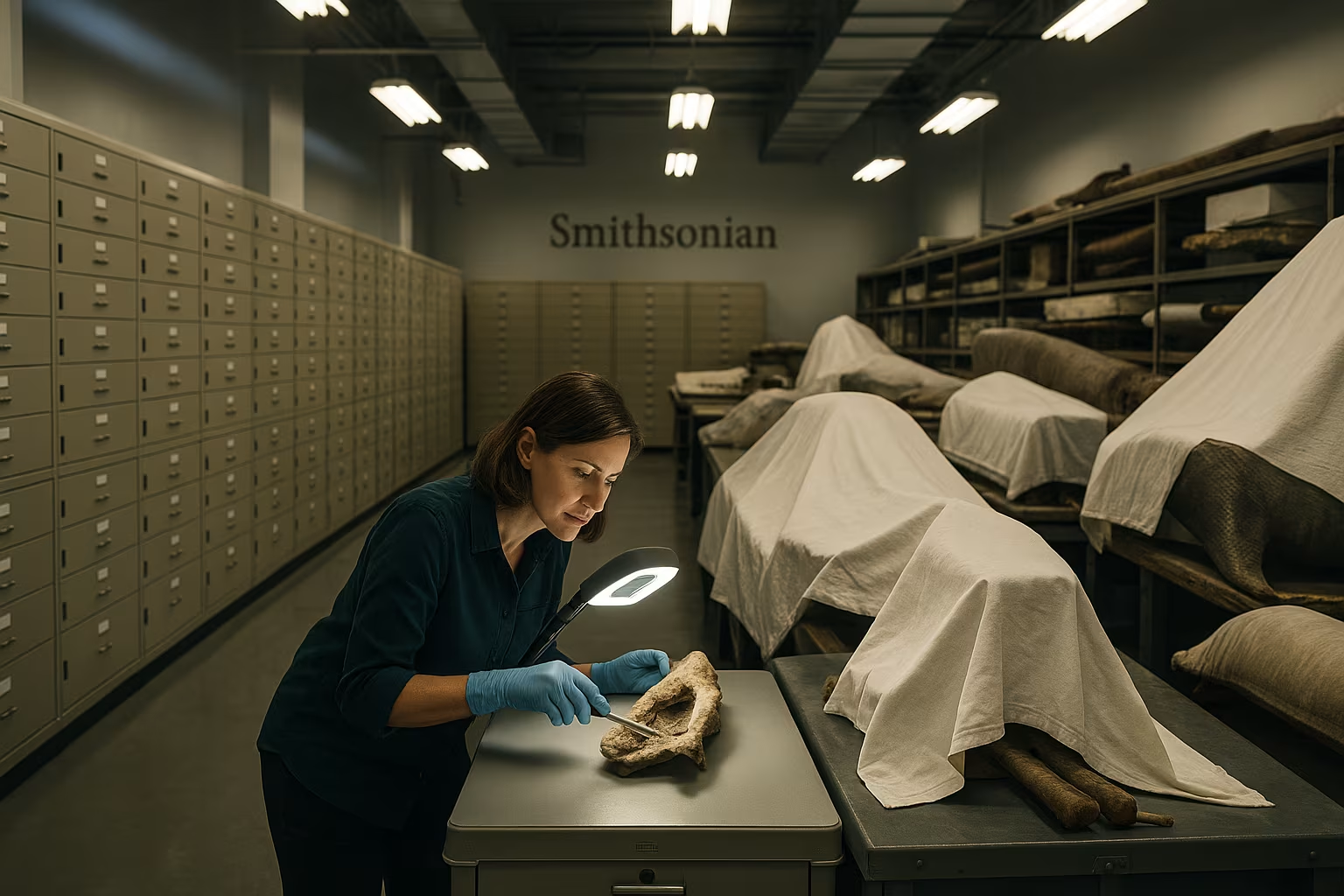The Smithsonian Institution is often called “the nation’s attic,” but the nickname hardly does justice to its scale. With 148 million specimens and artifacts ranging from tiny pollen grains to priceless space capsules, it is the world’s largest museum, education, and research complex.
While millions of visitors each year marvel at exhibitions in Washington, D.C., New York, and Virginia, most of the collection is never on public display. Instead, these treasures are meticulously safeguarded behind the scenes, in climate-controlled vaults, specialized storage facilities, and research labs where access is strictly monitored.
Here’s how the Smithsonian preserves this vast and irreplaceable archive of human history and the natural world.
1. A Network of Facilities
The Smithsonian’s 21 museums, nine research centers, and the National Zoo house only a fraction of the collection. Much of it is stored at the Museum Support Center in Suitland, Maryland — a sprawling campus of secure buildings with hundreds of thousands of square feet of storage space.
Other key facilities include the National Museum of Natural History’s offsite storage for fossil and mineral specimens, the National Air and Space Museum’s Udvar-Hazy Center in Virginia for large aircraft and spacecraft, and specialized archives for rare books, photographs, and film.
Each facility is tailored to the type of material it protects, ensuring conditions are optimized for long-term preservation.
2. Climate and Environmental Control
One of the most critical elements of specimen preservation is environmental stability. Fluctuations in temperature and humidity can warp, crack, fade, or corrode materials.
To prevent this, storage areas are maintained at carefully controlled levels — often around 70°F (21°C) with 45–55% relative humidity for mixed collections, though some artifacts require colder or drier conditions.
Sensitive biological specimens, such as insect samples or plant matter, are often kept in freezers or refrigerated rooms to prevent mold and insect damage. Film, audio tapes, and digital storage media are preserved at cooler temperatures to slow chemical degradation.
3. Specialized Storage for Different Materials
The Smithsonian’s collection is incredibly diverse, requiring tailored preservation strategies:
- Natural History Specimens: Minerals, fossils, bones, and taxidermy animals are stored in steel cabinets, while botanical specimens are pressed and mounted on archival paper inside climate-controlled herbarium cases.
- Cultural Artifacts: Textiles, paintings, and sculptures are placed in acid-free boxes or wrapped in inert materials to prevent chemical reactions.
- Aircraft and Spacecraft: Massive artifacts like the Space Shuttle Discovery are stored in hangar-like buildings with advanced air filtration and fire suppression systems.
- Documents and Photographs: Kept in archival folders and boxes, away from light, with digitization projects reducing the need for physical handling.
4. Integrated Pest Management
A collection this large is vulnerable to pests — from tiny beetles that feed on fabrics to silverfish that damage paper. The Smithsonian employs an Integrated Pest Management (IPM) program, which includes:
- Regular inspections and traps in all storage and exhibit areas.
- Quarantine procedures for new acquisitions to ensure no pests are introduced.
- Freezing or anoxic (oxygen-free) treatments to eradicate insects in contaminated items without chemicals.
This approach minimizes the use of pesticides, protecting both artifacts and staff.
5. Disaster Preparedness and Risk Management
The Smithsonian plans for worst-case scenarios — fire, flooding, earthquakes, and even terrorism. Disaster preparedness includes:
- Redundant storage: Some critical specimens are duplicated or have backups in different locations.
- Emergency kits and staff training: Ready-to-use kits for salvage operations include tools for drying wet documents, stabilizing broken artifacts, and sealing containers.
- Detailed response plans: Every department maintains protocols for quickly securing collections in emergencies.
These measures proved vital during events like Hurricane Isabel in 2003, when flooding threatened parts of the National Museum of American History.
6. Security and Access Control
Not all preservation is about the environment — some is about security. The Smithsonian limits access to storage areas to authorized staff, researchers, and conservators.
Security includes:
- Surveillance systems and restricted keycard access.
- Inventory tracking using barcodes and digital databases.
- Periodic audits to ensure items remain in their designated locations.
Digital assets, such as scans of rare documents, are stored on secure servers with backups to prevent loss from cyber threats.
7. Conservation Science in Action
The Smithsonian employs conservators who combine art, science, and engineering to repair and stabilize artifacts. These experts:
- Remove corrosion from metals.
- Repair tears in historical textiles.
- Clean and reline paintings.
- Restore mechanical functionality to historical instruments.
Conservation labs are equipped with microscopes, X-ray machines, and spectrometers for non-invasive analysis, ensuring treatments do not damage the artifact’s integrity.
8. Digitization to Reduce Handling
Every time an artifact is handled, it risks damage. To minimize this, the Smithsonian has embarked on large-scale digitization projects — photographing, scanning, or creating 3D models of specimens.
Digitized collections allow researchers worldwide to study items without physical access. They also serve as a digital backup in case of loss or deterioration.
As of recent years, tens of millions of images have been made publicly available online, ranging from Civil War portraits to rare fossils.
9. Collaboration and Research
Preservation is not just about storage — it’s also about active study. Smithsonian scientists and partner institutions regularly examine specimens to learn more about history, climate change, biodiversity, and cultural heritage.
Collaboration ensures the latest preservation techniques are adopted, from new archival materials to advanced environmental sensors that provide real-time data.
10. Adapting to the Future
Climate change, new conservation science, and shifting cultural priorities all shape how the Smithsonian safeguards its treasures. Increased humidity from more intense storms, for example, requires better flood defenses, while digital preservation raises questions about maintaining future readability of today’s file formats.
The institution continually updates its strategies, balancing access for education and research with the responsibility to protect these materials for generations to come.
The Smithsonian’s 148 million specimens are not just objects — they are pieces of humanity’s shared story, representing natural wonders, scientific breakthroughs, and cultural heritage. Safeguarding them requires a combination of cutting-edge technology, traditional craftsmanship, and constant vigilance.
From climate-controlled vaults to advanced pest control and disaster preparedness, every detail matters in ensuring these irreplaceable items survive another century — and beyond.
The next time you stroll through a Smithsonian gallery, remember that what you see is just the tip of an iceberg protected by an invisible network of science, security, and dedication.





